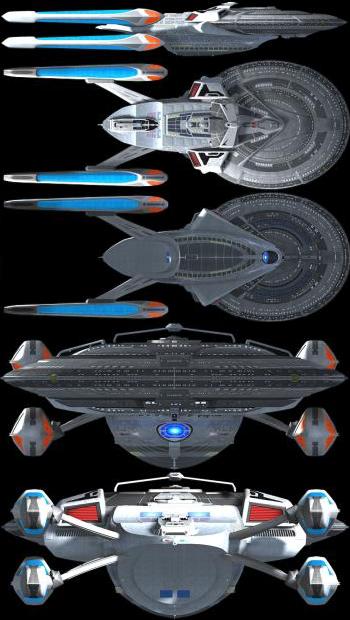|
Class History: |
The Jupiter-Class line is one of the largest vessels ever produced
by Starfleet, surpassed only by the Concorde-Class Starcarrier and the
later Pathfinder-Class and the Hyperion Class Starships in size. With her 53 Decks and nearly 900
meter length, she is virtually a city in space. Originally named the
Geneva, the Miranda-A was recommissioned when her previous namesake was
destroyed.
In the year 2366, design began on a new starship class.
Starfleet had Intelligence at this time of the Klingons developing their
Negh'Var Class warship, not to mention the immense size of the Romulan
Warbirds. It was felt that Starfleet would need a ship big enough to stand
toe-to-toe with any alien vessel that proved a threat. Utopia Planitia
Fleet Yards, in conjunction with the Avalon Shipyards and technical
advisors Admiral Victor Murdock, Admiral Michael Berman, Captain Okuda,
Admiral ( then Captain ) Michael Jarovik, Commander Kilrathi Nevil, and
Dr. Leah Brahms, were charged with the project. Starfleet Engineers
assisted by S.T.O.A.T. special forces engineers are nearly finished with
the work in just under four years. Many designs were used from the
Sovereign, Intrepid, Defiant, and Prometheus projects. Starfleet devoted
an incredible amount of resources to completing the two prototypes, the
USS Jupiter and USS Geneva (which was commissioned as the USS Miranda
NCC-77000-A)
These ships are Starfleet's great experiment. Nearly
every proposition and experiment has been absorbed into her design. She
will be a new breed of starship. Her oversized impulse engines provide
superb sublight maneuvering speed, especially considering her size. She
incorporates every weapons system known to Starfleet, supports triple
computer cores and a twin type-D trelinium/dilithium hybrid reactor. In
the description of Lieutenant Commander Elim Sivek, she is "one big, bad
momma."
Early 2366: Starfleet issues a general design brief for a
multi purpose defense vessel capable of Deep Space, combat and diplomatic
missions. The general idea is for what is almost considered a
super-starship based around the Sovereign design ideals. Two project
briefs are handed to Starfleet for the Jupiter and Behemoth Classes. The
Behemoth Class is rejected by Starfleet. Permission for base designs are
approved on the Jupiter Class. Starfleet views the theoretical proposals
for the Jupiter based on the defense parameters. After deliberation, the
Jupiter's primary design is approved and briefs for the propulsion,
computer, weapons and spaceframe parameters are sent out to Starfleet
design agencies for consultation.
Late 2366: Propulsion dynamic
are approved and sent to the Jupiter Station for in-depth study. Later in
the year M/ARA design is standardized for the Class. Spaceframe design is
approved and full specifications are forwarded to McKinley Station for
designations. USS Jupiter and USS Geneva production begins with a
projected 11 year turnover for the prototypes. Sovereign Class saucer used
as a base, and made standard in the Class. Sovereign Class nacelles
'borrowed' by the Jupiter Design team, with some modifications made from
designs on the Prometheus and Pathfinder projects.
Early 2367:
Design team use Sovereign warp coils and a brand new warp core for the
prototype. The primary hull begins construction. Late 2367: Primary hull
65% completion. Computers are delivered for fitting work.
Early
2368: Work continues on habitat and out hull sections for USS Jupiter and
USS Geneva . Late in year computer cores are activated and ship functions
begin to be transferred from Station Control to ship control. Late 2368:
Computer system now operating at 60% of maximum. System expected to become
self aware within the year. Warp Core begins primary testing. Antimatter
regulation control is found to be outside acceptable levels. Primary
magnetic containment malfunction found to be a problem. Primary hull 100%
complete bridge module attached.
2369: Warp core passes Review
Three and it tested to 90% peak. Computer system fully self aware and
umbilical from the station are cut as the ship become self sufficient.
Impulse systems pass Review Three and being autonomous low level power
control. Secondary backup generators are shut down and become auxiliary
system control. Weapons systems installed. USS Jupiter and USS Geneva
leaves Dry Dock for primary testing.
2371: USS Jupiter and USS
Miranda goes to Utopia Planitia early in year. Warp Stress Coating is
applied and USS Kelvin and USS Miranda begins Deep Space assessments. USS
Miranda completes construction reviews ahead of schedule and begins
testing.
2372: USS Jupiter and USS Geneva returns to the McKinley
for final exterior markings and paint. On 1, November 2372 the USS Jupiter
is officially commissioned by Starfleet at McKinley Station during a brief
ceremony. Bridge plaque is put in place and Captain V'ree'chak takes
command of the Jupiter from test Captain Wilson Agnew. USS Jupiter is
ordered to begin shakedown cruises estimate to last two years, while USS
Geneva is commissioned as USS Miranda-A and is made the flagship of Fleet
Admiral Victor Murdock.
2382: USS Montana-A commissioned after
previous USS Montana deemed unspaceworthy. It launches from Starbase 117 and
is given to Captain Sanford Armstrong. |
